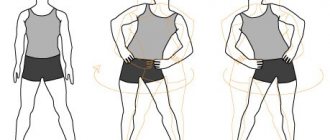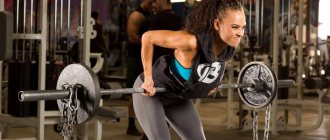For the workout to be fruitful, you need to stretch your muscles. It won't take much time, and you will feel the results from the very beginning of the workout.
If you properly warm up before starting your workout and stretch after it, your training will be more effective and you will be less likely to get injured.
The 10 minutes you save by ignoring these important training components may come at a very high cost, such as missing the desired results or a nasty injury.
Warm-up is the introductory part of the workout, the purpose of which is to prepare the body for more intense loads. It performs this function perfectly, significantly increasing the effect of the main activity.
At the same time, warm-up exercises are effective on their own. Their daily implementation normalizes blood circulation, strengthens joints, increases muscle tone, and promotes weight loss.
Purpose of warm-up
Why do you need to warm up? Why not get straight to the main goal? – many are perplexed. The fact is that warming up “triggers” changes in the body that optimally prepare it for the work ahead.
If you do not warm up, these changes will begin to occur during the main load, which will reduce efficiency. Also, without warming up, there is a high risk of injury and attacks of chronic diseases. Let's give an example of the simplest possible warm-up.
What are these changes?
- Warming up improves neuromuscular interaction - reactions accelerate, coordination of movements improves.
- Metabolism becomes more intense. Body temperature rises, sweating accelerates, facilitating the process of removing waste products from the body.
- The work of the circulatory and respiratory organs, which provide the muscles with oxygen and substances that provide the necessary energy for muscle contraction, accelerates.
- Muscles and ligaments become more elastic. This reduces the risk of injury.
- The endocrine glands begin to work differently. Because of this, restructuring occurs in the body faster and easier.
- The volume of blood in the bloodstream increases. This makes it easier to transfer oxygen and other substances important for the normal functioning of the body.
Why do you need a warm-up?
What are the benefits of warming up before training?
- First of all, you warm up the muscles, tendons and ligaments. Reduces the risk of injuries and sprains.
- Muscles that are pre-warmed cope better with the loads during training.
- Blood circulation improves, oxygen and nutrients are supplied to the muscles. This has a beneficial effect on muscle endurance.
- Warming up helps the body release hormones that are responsible for energy production.
- A good warm-up prepares the body for stress in terms of attitude and mentality. Improves attention and coordination.
- Surprisingly, during the warm-up, adrenaline is released into the blood, due to this the body better copes with the loads during training.
You can't neglect warming up. Some may say that they have never warmed up before training and feel fine without any injuries. Don't rely on other people's dubious experiences.
Each person has their own individual characteristics of the body. At a young age, microtraumas and microtears of muscles heal very quickly, sometimes a person does not even notice it. However, with age, this makes itself felt, recovery occurs more slowly, and the joints wear out. There is no need to put yourself at risk again.
Considering that most people do not have special knowledge about the correct conduct of sports activities and training, there is a possibility that they already make many mistakes when performing exercises, etc. Therefore, it is worth following at least the standard warm-up tips in order to protect the body from injury.
Warm-up rules
It is important to always remember simple rules:
- Since the work of the digestive organs is inhibited during warm-up, it is not recommended to eat one and a half to two hours before and after training. If it is impossible to maintain the required interval, have a light snack.
- You can start the main exercises 3-5 minutes after warming up, but you can do this later.
- The warm-up itself should last at least 10 minutes and more than 50 minutes, unless, of course, it is the main activity.
- The “correct” warm-up consists of two parts – general and special. During the general part, the work of physiological systems responsible for muscle function - nervous, respiratory, motor, cardiovascular, thermoregulation, etc. - becomes more intense. During the special part, those parts of the motor system that will be involved in the upcoming activity are prepared for work.
If you have ever been diagnosed with high blood pressure, heart disease, other organs, or the musculoskeletal system, you should start exercising only after consulting a doctor.
The importance of warming up before training
If you look at the warm-up process from different angles, you can identify several definitions of this concept:
- This is mental preparation for training. After a warm-up, it really is easier to train.
- This is warming up the muscles, optimizing the activity of the cardiovascular system and respiratory organs, improving blood circulation before exercise.
- This is the training phase. Indeed, this is a preparatory stage in the training process.
Before training, warming up is a must.
From a calm state to an active state
At rest, the human body functions in energy saving mode: it consumes calories to a minimum, the heart beats at a frequency of 55–60 beats per minute, breathing is calm and even. This is especially true for sleep.
When we wake up, calorie expenditure increases. Try to wake up and suddenly jump up and run somewhere. It will be very difficult, because the body is still sleeping, and we forced it to work as usual during the day.
That's why we wake up slowly: some are lying in bed, some are drinking coffee, some are doing exercises (by the way, a very useful thing).
The fact is that blood pressure immediately after sleep is quite low - after all, the muscles did not tense all this time, the heart beat calmly and measuredly in the chest.
Please note that when we go out into the street, we do not immediately engage the last gear and speed at 10 km/h, and do not run to our destination. We start with a slow walk, gradually moving to a fast or even run. But all this is being done gradually. Even if you just walked for 10 seconds and then started to speed up, this is considered “not right away.”
At the level of innate reflexes, our body knows that it is impossible to start doing something right away. It is necessary to prepare the body for a new state. This is why warm-up exists, to prepare the body for hard physical work.
To do this you need:
- Raise body temperature.
- Speed up the pulse, increase blood circulation.
- Stretch the muscles, saturating them with nutrients and oxygen due to the blood flow, raising their temperature
- Warm up the joints, stimulate their lubrication with synovial fluid.
This preparation of the body becomes especially important before hard work. Therefore, warming up before training is a mandatory step. Without it, it is difficult to force the muscles to work effectively, and it is very easy to get injured. Now you understand the importance of warming up before training.
Warm up before strength training
This is not only a precautionary measure, it also has positive long-term effects. A good warm-up routine will prevent injury and increase weight gain by warming up your strength and concentration.
An important element is monitoring your heart rate. Try to work in the first pulse zone and select warm-up exercises before the main workout in such a way that they do not overload your body and it does not become acidic ahead of time. Monitor your heart rate using the heart rate monitor on your arm. In this case, it is necessary to select light physical complexes, and the heart rate should be from 50 to 65% of the maximum.
Performing a warm-up routine will help develop the entire body as a whole and the functioning of the heart. The optimal warm-up duration is from 10 to 20 minutes. For strength training, when performing the FIRST exercise on a specific muscle group, it can consist of three stages:
First stage
The first thing you need to concentrate on during the warm-up is to pump up your muscles a little. The best way to do this is to perform 1-2 sets of 8-12 repetitions with a very light weight.
Feelings: at first you will be a little uncomfortable, there is a feeling of weakness. After the second set you begin to feel stronger.
Second phase
The next step is to prepare the muscles to lift heavy weights to failure. The next two sets should be performed with a load very close to what you will use in the first working set. Do only 1-2 repetitions, you will not tire your muscles and will not provoke microtrauma.
Feelings: It’s already hard for you, but it’s just a mental block that you will overcome. This is why warming up with weights is useful. The last approach is more difficult to perform, but you will begin to feel more confident.
Third stage
It is a mistake to believe that the next step in the warm-up is the transition to working approaches. After a hard warm-up, you should definitely rest for 2-3 minutes. This will reduce fatigue, and at the same time blood flow will remain at the same level.
Feelings: after the previous warm-up sets, you will perform this set confidently.
Next steps
You don't repeat the pre-workout warm-up exercises, but simply continue doing strength sets (most lifters do 2-4 sets of each exercise).
After warming up for one muscle group, you do not need to repeat the warm-up for that group throughout the entire gym session. For example, if you plan to deadlift, a light set of 8 reps with 40-60% of the lifting weight is sufficient as a warm-up.
But remember that it is better to warm up each muscle group. For example, if it's leg day, you should do squats first. Get into position and do a few warm-up sets. You will increase flexibility specifically for this exercise and prepare your body directly for squats. But you shouldn’t straighten your legs as a warm-up.
Sometimes the weight will seem unnaturally light or excessively heavy. If this happens, do another warm-up set with a load, and the heavy feeling should go away. The best way to prepare for a work set is to approach it with a feeling of confidence and strength, without fatigue.
This is exactly what a warm-up will help achieve.
Warm-up plan before working out in the gym
Joint gymnastics
Rotational movements, turns and/or bends in each direction, starting from the neck and ending with the ankle joint. When stretching your neck, avoid rotation, as this part of the spine is extremely vulnerable and any axial loads are potentially dangerous.
Tilt your head to the sides, forward, and gently back (the chin reaches toward the ceiling). After this, carefully knead the rotator cuff of the shoulder joint - to do this, swing in different planes - to the sides, back, up.
Then perform rotational movements in one direction and the other in:
- shoulder joints;
- elbows;
- brushes;
- lumbar spine (if axial loads are contraindicated, replace rotations with tilts);
- hip joints;
- knee;
- ankle.
Do 10-15 repetitions at an average pace. The time for performing joint warm-up before training is 2-3 minutes.
Stretching
Dynamic stretching exercises for all muscle groups mobilize muscle tissue, stretch fascia, stimulate the flow of oxygen to muscle cells, and prepare muscles for power load. The complex is carried out on a top-down basis. Pay special attention to large muscle groups - pectoral muscles, latissimus dorsi, spinal extensors, hip adductors and hamstrings. At the points of maximum tension, it is enough to linger for 5-10 seconds.
Hanging on a bar is suitable for stretching all muscles. To stretch your pectoral muscles, place one hand on a squat rack and lean your whole body forward or spread your arms out to the sides and back as far as possible. To stretch your lower back and hamstrings, do a straight-legged forward bend or hyperextension. Lunges are suitable for stretching the leg muscles.
When performing stretching exercises, you should feel muscle tension, but not pain or discomfort. The complex execution time is 2-3 minutes.
Cardio
Cardio warm-up prepares the cardiovascular system for physical activity. Perform light aerobic exercise with a heart rate of 130 beats per minute. This speeds up metabolism and triggers the processes of lipolysis - the oxidation of adipose tissue.
Cardio warm-up options include walking on a treadmill, elliptical or stepper, walking with high knees, arms and legs. The duration of the complex is up to 5 minutes. Finish when you feel that your body temperature has increased slightly.
Life hack: start your cardio warm-up wearing relatively warm sportswear, such as a sweatshirt, and when you warm up, take it off.
Strength warm-up
For the strength phase of the warm-up, experts recommend CrossFit exercises with minimal weights - no more than 20-30% of the workload. Pay special attention to the muscle group you are training today.
For example, on shoulder day do straight arm swings with ~4 kg dumbbells, on arm day do curls with dumbbells, on chest day do wall push-ups, on leg day do 3 sets of squats. You can perform exercises from the main workout, but in a simplified technique. When performing a strength warm-up, it is important to isolate each muscle group and load it specifically. Therefore, choose isolated exercises, and not, for example, deadlifts.
Options for strength exercises to warm up before training (do it selectively):
- Neck – bend the neck while lying down with a disc on the back of the head or on the forehead. 2 sets of 20 reps.
- Shoulders – standing, swinging dumbbells to the sides or in front of you//barbell row with a wide grip to the chin. 2 sets of 25 reps.
- Chest – push-ups//crossover crossover. 3 sets of 20 reps.
- Back – hyperextension//upper side row with wide grip//pull-ups with wide grip. 2 sets of 15 reps.
- Arms – lifting from the lower block with an EZ-handle to the biceps//extension of the arms from the upper block with a rope handle. 3 sets of 20 reps.
- Press crunches while sitting in a machine. 2 sets of 25 reps.
- Legs – squats with your own weight // leg abduction, sitting in a machine // leg curls, sitting in a machine // leg extensions, sitting in a machine. 3 sets of 20 reps.
The duration of the strength warm-up complex is no more than 5 minutes.
Full body workout
If the athlete slightly warms up the muscles, there is no harm. However, if you stretch for too long, more than 15-20 minutes, the muscles will have difficulty contracting. And this will negatively affect your results.
It's better to do warm-up exercises before training, and leave stretching for dessert.
Only in some cases is it useful to stretch before training. For example, if the muscles are too stiff, using a simple complex you can relax them and bring them into working condition. But because there isn't as much blood flow to the muscles before a workout as there is afterward, stretching can lead to pain and injury.
We recommend the following basic warm-up complex. They are intuitive and reminiscent of the warm-up series that we all did at school in physical education lessons. It will take you no more than 5 minutes to complete 10-12 exercises. Want to get a better workout? Complete 2 laps.
Full body warm-up complex
Stretch the neck muscles to the sides
- 10-15 seconds
- Body Part: Neck Equipment: No
Hand rotations
- 10-15 seconds
- Body Part: Shoulders Equipment: No
Dynamic stretching of the back muscles
- 10-15 seconds
- Body Part: Lat Equipment: No
Dynamic pectoral stretch
- 10-15 seconds
- Body part: Chest Equipment: Body weight
Delt stretching
- 10-15 seconds with each hand
- Body part: Shoulders Equipment: Body weight
Jumping lunges
- 10-15 reps
- Body Part: Hamstring Equipment: No
Standing bent leg rotations
- 10-15 seconds with each leg
- Body part: Adductor muscle Equipment: Body weight
Circular movements of the knees
- 10-15 seconds clockwise and counterclockwise
- Body part: Calves Equipment: Body weight
Swing your leg forward and backward
- 10-15 seconds with each leg
- Body part: Hamstrings Equipment: Body weight
Ankle rotation
- 10-15 seconds with each leg
- Body part: Calves Equipment: Body weight
Add to Calendar * Add to My Workouts * Print Workout
* — The service is in beta testing
Basic warm-up movements can be effectively combined with cardio and light strength training. Let's look at what other exercises you have in your arsenal.
Warm-up exercises
It is better to start doing exercises from the upper parts of the body, gradually descending to the lower parts.
Tilts and circular rotations of the head
Stand up straight, straighten your back. Shoulders should be down. Relax. Lower your head down, touching your chest with your chin. Move your shoulders slightly forward, round your back. Then tilt your head back, keeping your shoulders as far apart as possible. Tilt left and right by touching your ear to your shoulder. It is enough to do 10-15 tilts in each direction.
For circular rotations, take the starting position and relax. Rotate your head, making 15 rotations in both directions. Do not make sudden movements; rotations should be smooth.
Shoulder Raises and Rotations
Take your starting position. From there, start lifting your shoulders up, as close to your ears as possible.
From the starting position, begin to rotate your shoulders, alternating directions. Try to bend back and forth as much as possible. Twenty repetitions will be enough.
Circular rotations with hands
From the starting position, extend your arms forward and begin rotating in different directions. The number of repetitions is from 20 to 30 in each direction. The rotation speed should not be fast, and you should not feel pain when rotating.
Wrist rotations
You can do it in two ways. Stretch your arms to the side, fix the position and begin smooth rotation in the places of the hands. 15-20 rotations in each direction.
The second way is the “lock” exercise - clench your hands, insert the fingers of one hand between the fingers of the other to make something like a lock. In this position, rotate your hands, doing 20 repetitions in each direction.
Turn with arms extended to the side
Take the starting position, your feet should be shoulder-width apart. Your arms should be bent at the elbows and parallel to the floor, with the fingers of one hand touching the fingers of the other. From this position, make a turn in any direction, while your legs should remain in place, the hip joint works. After making the turn, spread your arms out to the sides and then return to the starting position. Repeat 10-15 times. To improve efficiency, arm extensions can be done with a jerk.
Four-way tilt
Take the starting position, spread your feet shoulder-width apart. Place your hands on your side. From this position, alternately bend forward, backward, left and right, straightening and returning to the starting position after each bend. Repeat the set of inclinations at least 10 times.
Circular movements of the pelvis
Get into the starting position with your hands on your waist. Your feet should be slightly more than shoulder-width apart. Rotate your pelvis clockwise, then change direction. The hip joint should draw a circle with as large a radius as possible. Do about 20 rotations in each direction.
Rotation of knees and feet
These exercises warm up your knees and ankles. Place your feet close to each other, your knees should touch each other. Bend over and place your palms on your kneecaps. In this position, rotate your knee joints. Do 10-15 repetitions on each side. A similar exercise can be done with legs apart, as shown in the picture below.
To warm up your feet and ankles, place your foot on your toes and begin to make “picking” movements, as if you want to drill a hole in the floor. Rotate your foot in both directions, 10-15 times in each direction.
Cardio warm-up at home and in the gym
Circular - 3 laps
Easy jumping in place
- 30 seconds
- Body part: Calves Equipment: Other
Jumping forward in a half squat
- 30 seconds
- Body part: Quadriceps Equipment: Body weight
High jump with uneven leg
- 5 reps on each leg
- Body part: Quadriceps Equipment: Body weight
Jumping rope
- 30 seconds
- Body part: Calves Equipment: Other
Add to Calendar * Add to My Workouts * Print Workout
* — The service is in beta testing
What else can be added to this circular series? The following two dynamic mini-series will make your training unforgettable. They are extremely simple to repeat and at the same time perfectly warm up all the necessary parts of the body for home workouts.
Dynamic hamstring stretch
The series consists of a half-squat, straightening the legs and pulling the torso up. On the exercise page you can watch the technique in detail in the video.
Dynamic hamstring stretch
Triple stretch
Lunge forward and squat down. Place your hand on the side of your leg in a lunge, with your other hand parallel to your working leg. Place your hands on either side of your front leg. Lift your toes and straighten your leg. Also, use video technology if necessary.
Triple stretch
What other simple exercises will help you quickly stretch your entire body at home?
Running in place with a high hip lift
In addition to everything listed above, we offer a “secret weapon” that will bring your body to full tone in 1 minute! Running in place is an excellent coordination and aerobic cardio endurance exercise. Since the movement involves almost all parts of the body, you will feel your heart rate increase to the desired value within 10 seconds.
Some girls have special equipment at home, for example, a fitball. If you were wondering how to do an effective warm-up at home using a regular exercise ball, now you have the answer.
Warm up with fitball
Often, when working on problem areas, one simple trick helps get things moving: you need to surprise your body. Do this unusual, incendiary workout on a fitball with us.
Yoga warm-up routine
Successful and time-tested exercises can be borrowed, for example, from yoga. We suggest you try the warm-up complex “Sun Salutation - Surya Namaskar”, which will warm up the whole body in 2 minutes.
If everything is clear with the warm-up, then there is a lot of controversy about stretching before training.
Stretching before or after exercise
The best time to stretch is immediately after a workout. You don't have to worry about the possibility of lower results. When you finish working out in the gym, your muscles are still tense. They pump with blood and oxygen, giving them a better range of motion.
Stretching after exercise is beneficial because it prevents some of the negative effects.
A muscle strain is caused by the pulling of antagonist muscles. After the negative or lengthening phase of the exercise, they are fully stretched. Thus, a good stretch for any muscle is the usual relaxation after exercise. For example, you’ve finished a set of pull-ups, just hang there.
But some exercises don't allow you to stretch. Want to succumb to the weight of a barbell in a squat position for 60 seconds? You'll be more concerned about maintaining your balance than the quality of your stretch. Below are some safe and easy stretches to tone your muscles.
The importance of warming up
Many beginners and some experienced athletes often skip the warm-up, starting classes with basic exercises. This is a fundamentally wrong approach. Warming up before training is not just an integral part of sports training, but its most important element. It prepares the body for upcoming stress. Consequently, how effective the lesson will be directly depends on the warm-up.
You need to start a good workout only with warm-up exercises. It is a mistake to consider their implementation a waste of time. Basically, this opinion is based on the belief that during warm-up there is no muscle tissue building or weight loss. Things are a little different. If the warm-up is done correctly, it helps to accumulate a large amount of strength required for pumping up muscles, or performing weight-loss exercises when a person wants to get rid of extra pounds.
The set of exercises included in the warm-up solves a wide range of problems:
- prepares both the muscular and skeletal systems, as well as all organs involved in the training;
- provides aerobic exercise, saturates muscles with oxygen and blood;
- dilates capillaries, strengthens the pulse, preparing blood vessels and heart muscle for stress;
- prevents injury while lifting heavy weights or working on exercise equipment;
- provides an additional release of testosterone with adrenaline;
- tones the sympathetic nervous system;
- accelerates cellular metabolism;
- increases the elasticity of muscles and ligaments;
- increases joint mobility;
- accelerates the transmission of nerve impulses;
- allows you to fully concentrate on the upcoming workout.
A high-quality warm-up before training helps to achieve the goal set for the athlete. If this is strength training, then the right attitude and preparation of the body allows you to do the exercises with maximum impact and lift a lot of weight. For fitness classes, the role of warm-up exercises is also great. They give confidence to every movement, make the body even more agile, and increase flexibility.
Stretching set before and after training
Standing biceps stretch
- 10-15 seconds
- Body Part: Biceps Equipment: No
Standing triceps stretch
- 10-15 seconds
- Body part: Shoulders Equipment: Body weight
Delt stretching
- 10-15 seconds
- Body part: Shoulders Equipment: Body weight
Stretch the neck muscles to the sides
- 10-15 seconds
- Body Part: Neck Equipment: No
Sitting stretch
- 10-15 seconds
- Body Part: Lower Back Equipment: No
Stretching the calf muscles using an elastic band (foot turned inward)
- 10-15 seconds
- Body part: Calves Equipment: Other
Quadriceps stretch while lying on your side
- 10-15 seconds
- Body part: Quadriceps Equipment: Body weight
Add to Calendar * Add to My Workouts * Print Workout
* — The service is in beta testing
Ultimately, the effectiveness of stretching depends on which groups you emphasized in your training.
The importance of warming up and cooling down
It is important to know that warming up helps increase muscle size by expanding connective tissue, giving more room for growth.
To stretch the muscles before training, a few warm-up sets performed in the full range of motion are enough. If you want to stretch before a workout, first do a warm-up using the principle of “don’t stretch to warm up, warm up to stretch.” However, remember: you should not overstretch your muscles, as this may reduce your progress.
After completing the last set for each muscle group, immediately move on to stretching and do it for about a minute. The first 15-30 seconds you will feel relief, and the last 45 you will feel pain, but complete the exercise. Be sure to look at your watch while doing this.











